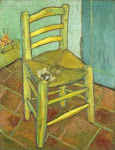
Autumn has arrived in Florida -- high of only 65 today in St Petersburg! Brrr...that's January weather! I had to excavate a sweater this morning from the depths of the closet, forgotten since about February.
In honor of the lovely fall weather (many folks outside FL actually have autumn leaves to see), here is one of Vincent's many autumn-themed pictures, "Autumn Landscape with Poplars," from October 1884, while he was living in Nuenen with his family. Today the painting is in the Van Gogh Museum, having made a circular route through galleries and collectors. Vincent loved fall, and he used his (at this point) newfound interest in complementary colors to celebrate the season: orange leaves, blue sky. He also used a perspective frame to construct the image, a wooden frame strung with string that he adopted early in his artistic career and continued to use until around May 1888 in Arles. The perspective in this picture is mostly successful, aside from the bridge-fence at left, which is a bit off, and the size of the farmhouse in the background, which is slightly too big. But in general Vincent displays his growing confidence both in the rendering of perspective and in the paint medium.
The woman walking into the foreground wears a traditional Dutch mourning shawl, a garment that Vincent seems to have admired for its visual qualities, as he depicted it more than once in paintings and drawings. Here, the theme of mourning and melancholy ties in to the passing of time and the passing of the seasons. But Vincent's attitude about autumn was not gloomy -- he considered autumn to be part of the cycle of life, and as such, it had its own beauty.













